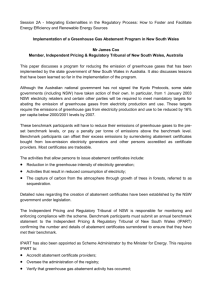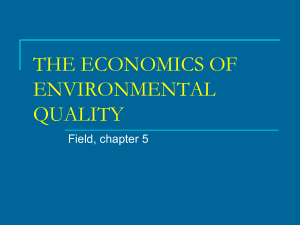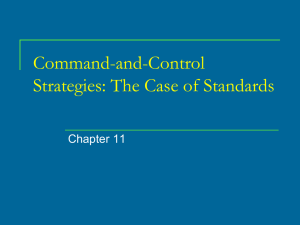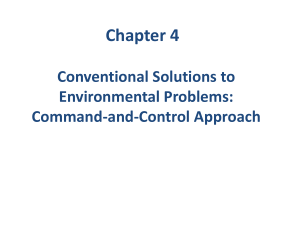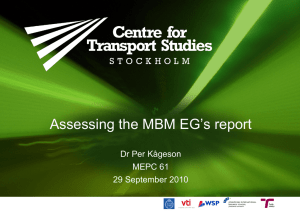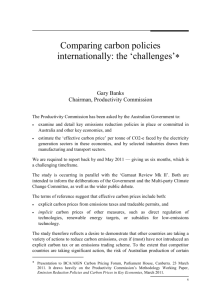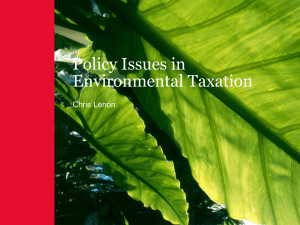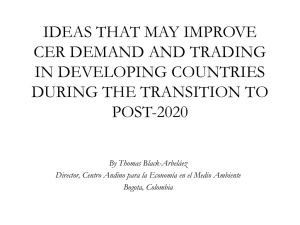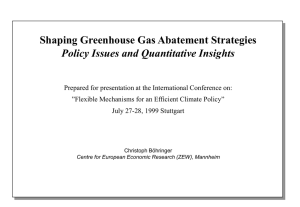Abatement of Greenhouse Gas Emissions
advertisement
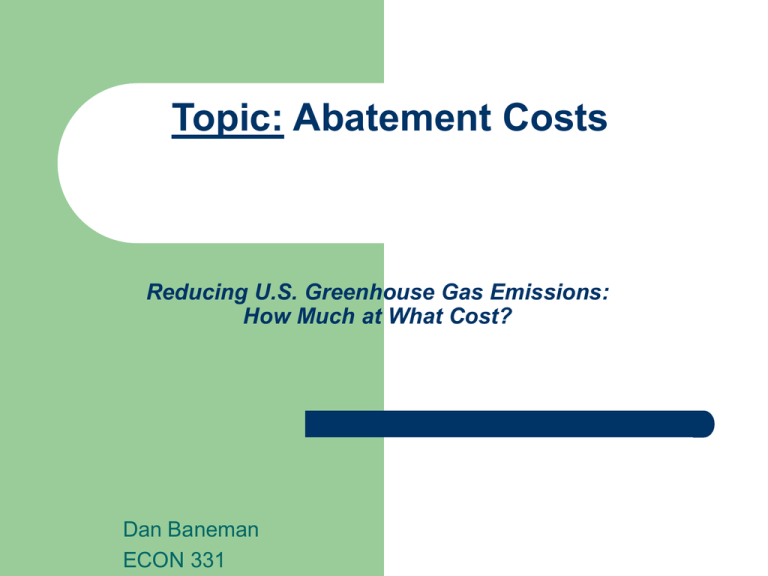
Topic: Abatement Costs Reducing U.S. Greenhouse Gas Emissions: How Much at What Cost? Dan Baneman ECON 331 Factors behind rising emissions in the US Continued expansion of US economy Rapid growth in buildings-and-appliances and transportation sectors – Greater use of carbon-based power in electric power generation – Driven by rising population and consumption Driven by construction of new coal-fired power plants without carbon capture and storage (CCS) technology Reduced absorption by forests and agricultural lands Annual GHG emissions projected to increase by 35 percent by 2030. – On current path, US emissions in 2030 would exceed GHG reduction targets in legislation by 3.5 to 5.2 gigatons Overview of Authors’ Approach Authors estimated net costs and abatement benefits in terms of CO2 equivalent reduction of more than 250 abatement options. Grouped options into clusters based on energy use patterns and technology features of different sectors. Limited focus to abatement options with a marginal cost below $50 per ton of carbon dioxide abated. Project a range of three outcomes for each option and integrate the values into abatement supply (marginal cost) curves. Overview of Authors’ Approach Low-range case – Mid-range case – Would bring annual emissions below current levels but would not be enough to reach goals laid out in legislative proposals. High-range case – Would reduce annual emissions by 1.3 gigatons by 2030; not sufficient to bring projected levels of GHG back to current levels. Would be required to meet objectives proposed in current legislation. However, this would require an extraordinary amount of national commitment. Authors focus primarily on mid-range case. Marginal cost curve: basic theory Price of carbon emissions Marginal Cost 0 Abatement 6 A real life abatement curve Negative marginal cost of abatement: How is this possible? Agency issues – Lack of information – Consumers can’t easily access information on energy efficiency from different appliances, different usage techniques, etc. Consumer desire for rapid payback – – Energy efficiency: mismatch between who pays the cost and who reaps the benefit. i.e., Irrationally high implicit discount rate Consumers may not properly value energy savings Some examples later on… Five main sectors for potential abatement Buildings and appliances Transportation Industrial sectors Electric power Carbon sinks 1. Buildings and appliances (B&A) Emissions from B&A expected to grow faster than any other sector, due to low efficiency and fast projected growth. Emissions expansion due to increased emissions from: – – Direct sources (e.g. on-site combustion of fossil fuels) Indirect sources (e.g. electricity consumed by commercial and residential buildings) Fast projected growth means large potential for low-cost abatement. – – Cheaper to install clean/energy-efficient technologies in new facilities than to retrofit later on. Thus, greater potential for low-cost abatement from expanding industries, since this potential abatement would be achieved through clean technologies in facilities that haven’t been constructed yet. Buildings and appliances (B&A) B&A has 51 percent of abatement potential in mid-range case (54 percent in high-range case). Negative-cost options result from: – Agency issues with alignment of incentives. Example: condominiums and energy-efficient installments. – – Builder/owner usually doesn’t pay the energy bill, but consumers only stay for 2-3 years, which isn’t enough time to reap returns individually. Lack of information (and high implicit discount rates). Example: insulation in homes – – – – Builders try to minimize “first cost,” and they don’t face any of the energy costs. Consumers usually don’t know much about insulation options. Exacerbated by consumers overvaluing immediate costs relative to longterm savings from energy efficiency. Result is poor insulation at a net economic loss for consumers. Buildings and appliances (B&A): Specific abatement opportunities Lighting – – Electronic equipment – – – Big opportunity due to large expected growth in number and energy intensity of devices, and large potential to improve per-unit energy consumption. Usage improvements (e.g. fewer stand-by losses) Better consumer knowledge (e.g. large variation in energy consumption of different types of TVs) HVAC (Heating, Ventilation and Air Conditioning) – – – Residential lighting tends to be inefficient compared to commercial lighting. Current technologies and new technologies being developed could result in substantial energy use reductions. (LEDs, CFLs, etc.) Potential rebound effect. More efficient HVAC equipment in both initial installations and retrofits Better building design Again, potential rebound effect Building shells – – Better shells in both commercial and residential buildings (e.g. insulation, reflective roof coatings) Much cheaper (as much as $80/ton) to install with initial construction than to retrofit Buildings and appliances (B&A) Specific barriers to address: – Information visibility – e.g. Energy consumed by a given appliance e.g. Information on energy savings from placing refrigerator in cool vs. warm room Agency issues Energy bill-payer may not be involved for full relevant time period to reap returns, so incentives for energy efficiency/GHG abatement aren’t aligned (e.g. condo example from before). 2. Transportation Projected improvements in vehicle efficiency are more than offset by growth in vehicle miles traveled, which is a function of the number of vehicles on the road and the average miles per vehicle. – – Sound familiar? Difference from earlier CAFE/rebound effect discussion is that we’re considering number of total vehicles as well as miles traveled per vehicle. Between 2005 and 2030: 96 million more cars and light trucks 11% increase in annual miles traveled by each vehicle. Transportation: Abatement opportunities Biofuels – – – Fuel economy – Emit less carbon Production costs declining due to innovation (science, refinery design) Cellulosic biofuels have lower production costs and carbon content than starch biofuels Technology upgrades improving fuel efficiency Hybrids – Less potential for low-cost abatement if there are efficiency improvements from biofuels and technology Transportation Barriers: – – Consumers’ willingness-to-pay for expected gas long-term savings (a la Alcott & Wozny) Depends on advances in cellulosic biofuel technologies to reduce production costs 3. Industrial sector: Abatement opportunities Recovery/conversion of non-CO2 GHGs (e.g. methane) Carbon capture and storage (CCS) – Combined heat and power (CHP) – Expected to become commercially available in industrial/manufacturing settings by 2020 Cost of savings (e.g. through switching from coal to natural gas) varies a lot by sector and geography Energy efficiency New product and process innovation Industrial sectors Barriers: – – – Energy price volatility adds risk (e.g. coal to natural gas transition), making returns on expenditures for energy efficiency improvements less certain. Investment hurdles. Where improvements are widely distributed, there may be disproportionate management costs. Lack of focus on energy efficiency. “The more you look, the more you find.” Industries aren’t always aware of costsaving abatement opportunities. 4. Electric power Carbon Capture and Storage (CCS) – – Wind power – Abatement cost will rise rapidly as attractive sites are unlocked and used up. Nuclear power Solar power – – – Captures concentrated CO2 emissions at the point of generation and stores them. Best economics when coupled with coal-fired power plants because of high carbon concentration of exhaust gases. Still an expensive, early-stage technology. No substantial abatement potential until 2020, but a lot of potential afterwards. Still expensive and relatively energy-inefficient Continued technological improvements expected High up-front system costs Natural gas (e.g. from coal) – Short-term solution, but not economically efficient for sustainable abatement because future natural gas sources are projected to be higher-cost, raising prices. Electric power Barriers – Technological development needed (CCS, renewables) 5. Carbon sinks: Abatement opportunities Afforestation (forest-planting) of marginal lands with low opportunity costs. – – – – 7% of US pastureland qualifies as marginal due to erosion and/or low productivity. Could be converted to forestland without affecting livestock production. Costs: opportunity costs, conversion costs, maintenance costs. The South has best potential to contribute (50%) With cropland: Conservation Reserve Program (CRP) encourages landowners to take marginal cropland out of production; this could be afforested without affecting crop production. Tillage practices Forest management Winter cover crops – – Planting legume or grass cover over harvested land in winter increased carbon-storing potential of the soil. Also reduces fertilizer needed during growing season by 30%, so it can save costs. Role for policymakers Coordinated set of abatement policies. – – Start quickly. – Many low-cost opportunities are “time perishable.” Negative cost options will start to disappear (e.g. cost of instituting energy-efficient technology is cheaper with initial construction than retrofitting). Many negative cost options aren’t happening currently. Need policy support for: – – Abatement options are widely distributed across sectors and geographical regions. Thus, a policy approach that doesn’t address the full range of options risks missing reduction targets and/or increasing total abatement costs to society. Visibility/information (e.g. money/energy savings from different appliances, putting refrigerator in a cool room, etc.) Change incentives to correct agency issues (cost/benefit mismatch) (e.g. insulation with builders vs. homeowners, condo owners vs. consumers) Visible, sustained signals to create certainty about the price of carbon and required emissions reductions. – This will encourage investments in options with a long lifecycle. Lack of information is a barrier to long-term investment. Key take-away points: Almost 40 percent of low-cost (below $50/ton) abatement is achievable at zero or negative marginal costs. – – i.e., Savings to society would offset spending. Why hasn’t this happened already? To reiterate: Abatement opportunities are spread across many different sectors. – Largest option (CCS for coal-fired power plants) offers less than 11 percent of total abatement potential Abatement potential and costs vary across geography. – – About 3.5 times as abatement potential (at less than $50 per ton) in the South than the Northeast (1130 megatons vs. 330 megatons). Sectoral variations. Agency issues. Mismatches between which parties incurs the costs and which parties reap the benefits. Lack of information about impact of individual decisions. Consumer desire for rapid payback when an up-front investment is required. Northeast: More low-cost B&A and transportation opportunities due to dense populations. South: More low-cost options in industrial sectors and afforestation. Significant abatement will require a coordinated policy response in order to achieve abatement targets at minimal cost to society.
